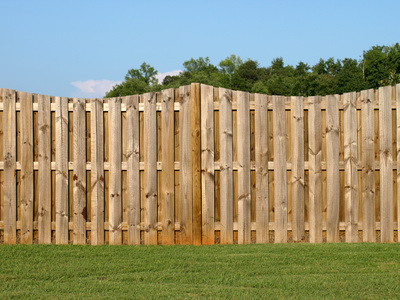Your fence is an extension of your property, and a huge part of your home’s curb appeal. Your fencing could add thousands in value to your property, so you should decide what fencing materials to consider before you build.
Auctioneer and realtor Gregory Goff posted an article by Leah L. Culler of MSN Real Estate called “13 Threats to Your Homes Value”.
It points out that not having a fence could threaten your home’s value by 5%-10%. On a standard home appraisal form, a premium is paid for your fence, so you can see it’s importance.
But deciding what materials to use must come first before you plan your fence style, hire a contractor and devise plans.
A fence adds 5%-10% value to your home
source: msm real estate
There are 4 main types of fencing materials:
-
Wood
-
Vinyl
-
Ornamental
-
Chain Link
 Wood:
Wood:
Different types of wood are chosen by price and regional availability as well as aesthetic co-ordination with your home. You may want to choose they type of wood that is native to your area, not only for price but also because it will compliment the environment. If you have a wood deck, you’ll want to choose a similar wood to compliment each other.
- Whitewoods: native to upper North America, whitewoods are common. Some whitewoods are pine, spruce and fir.
- Cedar: Cedar is a popular choice because it is naturally insect resistant and does not rot easily. in the western states you can expect to have Western Red Cedar available. In lower Canada and upper United State you can find Northern White Cedar.
- Yellow Pine: a durable and affordable choice is Southern Yellow Pine. You can find it in the Southeast and Midwest US.
- Redwood: mostly found on the west coast.
Treatment: Whitewoods usually need to be treated and the popular method is pressure treatment. This consists of forcing a chemical solution into the wood. This treatment helps the wood to resist rot and insects.
Because Cedar naturally does this, it doesn’t need treatment. Many pressure treated woods come with a 10 year-lifetime warranty, so check out your options before you buy. If you choose wood fencing materials, know that all kinds can be treated to repel water and insects with a special solution.
It is also a good idea to stain your wood, to seal it. It will add longevity to your investment.
Wood suppliers estimate that 80 percent of fences are made of Western Red Cedar or pressure treated pine.
 Vinyl:
Vinyl:
Fencing Materials made from Vinyl can look like natural wood or painted fencing, and it comes in many different textures as well. Because vinyl is colored solidly throughout, you don’t need to touch it up if there is a knick or chip.
It is also a man made material, so it can’t rot, warp, or become infested with insects. It also is stronger than wood, so it won’t snap easily.
Although vinyl can last much longer than wood, it is also more expensive. If you are a person that hates staining every year, then the expense could be worth the time you spend repairing wood and staining or painting.
Vinyl fences can be built to look like a common wooden fence, or with the boards forming a solid “wall”. A solid style is great for privacy but does run the risk of being knocked down in a high wind area. Those that live in a windy area might want to build a fence with some space between the boards.
Vinyl can also look like a ranch style post and rail, which is really cool for that homestead look.
 Ornamental:
Ornamental:
Wrought Iron and Aluminum fencing materials are both beautiful aesthetically and is a prestigious style. Used correctly it can highlight a beautiful landscape.
Because pickets are so far apart, it’s not a good choice for privacy. Pickets that are too wide can be a danger to small children or pets but a screen can be attached for added safety.
You can customize your look by using rings, scrolls, rails and finials. Pickets can also be customized. wrought iron and aluminum fencing come is a variety of styles and some standard colors.
Wrought Iron is a good choice if safety from trespassing is a priority because of it’s superior strength. Hand wrought, and usually hot dipped to protect against rust, it is a natural material not harmful to the environment.
Despite superior anti-rust treatments available, it may not be a good choice for homes near the ocean. Wrought Iron is very beautiful, durable and virtually maintenance free.
Ornamental Aluminum can made from 100% recycled material. According to industry standards, 70% of ornamental aluminum material should be recycled. Aluminum is more affordable because they are made with tubular bars that are prefabricated instead of hand wrought.
 Chain Link:
Chain Link:
The most used fence system in the world is chain link fencing. It is also the most economical and sturdy. Chain link fencing material is extremely flexible in it’s applications from commercial to residential use.
Families with small children and pets are more secure with chain link, and also easier on the wallet for young families.
A chain link fence is easy to see through, which makes it harder for trespassers to break in to homes without being noticed by the neighbors. Because of this many homeowners with small lots in urban areas choose this style.
Because if it’s affordability, many property owners with 1/2 an acre or more of land use this type. It can also help them protect livestock.
If privacy is an issue, you can customize your fence with slats. Slats can be made of wood, polyethyelene or wood. Chain Link Slats can be inserted in many ways for different looks; horozontally, vertically or diagonally, and come in many customizable colors.
The fence itself comes in many colors with a durable coating that prevents rust. Coating comes in many colors to choose from so the fence adapts to the surroundings. The most used colors besides traditional metallic coating are green and black.
Knowing what you want your fence for is a big part of your decision. Here’s a short checklist:
- Safety from trespassers
- Safety for Children or pets
- Pool Protection
- Privacy
- Longevity
- Low maintenance
- Aesthetic
- Protect a garden
- Protect livestock
- Keeping my nosey neighbor out of my business
But seriously, neighbors deserve a larger mention on this checklist. If you live in an urban or suburban environment, what you do to your home can also effect the value of other homes in the neighborhood, especially your direct next door neighbor. Alert your neighbor of your plans. Written approval from a neighbor with a shared property line is a requirement in many states, so make sure to check on that.
In many instances, your neighbor might also want to build a fence and will share the cost of fencing on a shared property line. Once you know what you want your fence for, decide the fencing materials you want to use, then hire a contractor. Happy fence building!
Do you have any fence building advice? Comment below, we’d love to hear your story.



Recent Comments
Original EZGT001 Gate Latch Pull In Black
Original EZGT001 Gate Latch Pull In Black
Original EZGT001 Gate Latch Pull In Black
Original EZGT001 Gate Latch Pull In Black
Original EZGT001 Gate Latch Pull In Black